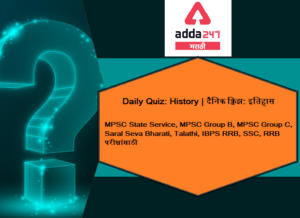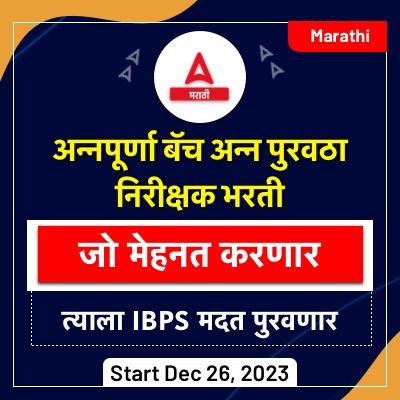
इतिहास दैनिक क्विझ मराठीमध्ये: 24 मे 2021
महाराष्ट्र राज्य लोकसेवा आयोग दरवर्षी वेगवेगळ्या परीक्षे मार्फत हजारो विद्यार्थ्यांची भरती करून घेते MPSC State Service, MPSC Group B, MPSC Group C, Saral Seva Bharati, Talathi, UPSC, SSC, RRB अशा अनेक परीक्षांमार्फत हजारो जागांची भरती दरवर्षी निघते ज्यात लाखो इच्छुक हजार किंवा त्याहूनही कमी जागांसाठी अर्ज करतात. आपण एमपीएससी आणि इतर परीक्षाची तयारी करत असाल तर आपल्याला क्विझ देण्याचे महत्त्व माहित असलेच पाहिजे. बर्याच विद्यार्थ्यांना अभ्यासाचे पुरेसे तास दिले जात असतानाही त्यांना या परीक्षांची पूर्तताही करता आली नाही कारण ते त्यांचे परीक्षण वेळेवर पूर्ण करू शकत नाहीत आणि संशोधन करण्याचा उत्तम मार्ग म्हणजे त्या संबंधित विषयाची किंवा विषयाची क्विझ देणे कारण आपण या मार्गाने कव्हर करू शकता कमी वेळात जास्तीत जास्त विषय. आम्हाला Add 247 मराठी येथे चांगल्या अभ्यास सामग्रीचे मूल्य समजले आहे आणि म्हणूनच आम्ही सर्व विषयांसाठी आपल्याला क्विझ प्रदान करीत आहोत. दैनिक क्विझ देऊन तुम्ही तुमच्या तयारीची पातळी तपासू शकता.
चालू घडामोडी, भूगोल, अर्थशास्त्र, पर्यावरण, सामान्य विज्ञान, इतिहास, पॉलिटी अशा सर्व स्पर्धात्मक सामान्य अभ्यास विषयांमध्ये इतिहासाचाही महत्वाचा वाटा आहे. तर चला इतिहास बद्दल तुमची तयारी तपासण्यासाठी खालील 24 मे 2021 ची इतिहासाची दैनिक क्विझ पहा.
Q1. ल्हासा करारासंबंधित खालील विधानांचा विचार करा
1. तिबेटची देय सुरक्षा म्हणून भारत सरकार चुंबी खोरे (भूतान आणि सिक्कीममधील भूभाग) 75 वर्षे व्यापेल.
2. लॉर्ड वॉली यांनी कर्नल यंगहसबँडला तिबेटमध्ये करारावर येण्यास भाग पाडण्यासाठी खास मिशनवर पाठवले.
वर दिलेले कोणते विधान/विधाने बरोबर आहे/आहेत?
(a) फक्त 1
(b) फक्त 2
(c) दोन्ही 1 आणि 2
(d) 1 किंवा 2 देखील नाही
Q2. प्रथम अँग्लो-अफगाण युद्धाच्या संदर्भात खालील विधानाचा विचार करा
1. उत्तर-पश्चिमेकडून हल्ल्याच्या योजनांवर कायमचा अडथळा आणण्याचा ब्रिटीशांचा हेतू होता
2. ब्रिटिशांनी अफगाणिस्तानचा स्वतंत्र शासक म्हणून दोस्त मोहम्मद याची ओळख होती
वर दिलेले कोणते विधान/विधाने बरोबर आहे/आहेत?
(a) फक्त 1
(b) फक्त 2
(c) दोन्ही 1 आणि 2
(d) 1 किंवा 2 देखील नाही
Q3. प्रामाणिकपणाच्या निष्क्रियतेच्या धोरणासंबंधी खालील विधानांचा विचार करा
1. जॉन लॉरेन्स उत्कृष्ट निष्क्रियतेचा एक धोरण सुरु केले
2. पहिल्या अफगाण युद्धाच्या आपत्तींवर ही प्रतिक्रिया होती आणि व्यावहारिक अक्कल आणि सीमेवरील समस्येचे अंतरंग ज्ञान आणि स्वातंत्र्याबद्दलच्या अफगाणिस्तानाचा हा परिणाम
वर दिलेले कोणते विधान/विधाने बरोबर आहे/आहेत?
(a) फक्त 1
(b) फक्त 2
(c) दोन्ही 1 आणि 2
(d) 1 किंवा 2 देखील नाही
Q4. प्राइड रिझर्व्हचे धोरण_____द्वारा सुरू केले गेले.
(a) लॉर्ड लिट्टन
(b) लॉर्ड वेलेस्ले
(c) लॉर्ड वाचन
(d) लॉर्ड डलहौसी
Q5. गंडमाक करारासंदर्भात पुढील विधानांचा विचार करा
1. शेर अली आणि ब्रिटीश यांच्यात तो करार झाला
2. यामध्ये काबूत येथे कायमस्वरूपी ब्रिटिश रहिवासी असण्याची कल्पना होती;
3. पहिल्या-एंग्लो अफगाण युद्धानंतर या करारावर स्वाक्षरी झाली
वर दिलेले कोणते विधान/विधाने बरोबर आहे/आहेत?
(a) फक्त 1
(b) 2 आणि 3
(c) 1 आणि 2
(d) फक्त 2
Q6. लॉर्ड कर्झन संबंधित खालील विधानांचा विचार करा
1. त्यांनी माघार व एकाग्रतेचे धोरण अवलंबिले.
2. त्यांनी पंजाबच्या लेफ्टनंट गव्हर्नरच्या खाली थेट उत्तर-पश्चिम फ्रंटियर प्रांत (एनडब्ल्यूएफपी) तयार केले
3. आदिवासींना शांतता राखण्यासाठी ते प्रोत्साहित करू शकले नाहीत.
वर दिलेले कोणते विधान/विधाने बरोबर आहे/आहेत?
(a) फक्त 1
(b) 2 आणि 3
(c) 1 आणि 2
(d) फक्त 2
Q7. पुढील जोड्यांचा विचार करा
1. मद्रासचा पहिला अँग्लो-म्हैसूर युद्ध-तह
2. सिरिंगपट्टमचा दुसरा अँग्लो-म्हैसूर युद्ध-तह
3. मंगलोरचा तिसरा अँग्लो-म्हैसूर युद्ध-तह
वर दिलेले कोणते विधान/विधाने बरोबर आहे/आहेत?
(a) फक्त 1
(b) 2 आणि 3
(c) 1 आणि 2
(d) फक्त 2
Q8 खालीलपैकी कोणत्या राज्यांनी वेलस्लेची उपकंपनी युती स्वीकारली?
1. सिंधिया
2. बुंदी
3. पेशवा
4. तंजोर
योग्य कोड निवडा:
(a) 1,2,3
(b) 2,3
(c) 1,4
(d) 1,2,3,4
Q9. सन्यासी विद्रोह संबंधित खालील विधानांचा विचार करा
1. या उठावात मुस्लिमांचा सहभाग नव्हता
2. देबी चौधुरानी या उठावात सहभागी झालेल्या महिला नेत्या होत्या आणि त्यांना आनंद गणिताच्या अर्ध- ऐतिहासिक कादंबरीत मान्यता मिळाली
वर दिलेले कोणते विधान/विधाने बरोबर आहे/आहेत?
(a) फक्त 1
(b) फक्त 2
(c) दोन्ही 1 आणि 2
(d) 1 किंवा 2 देखील नाही
Q10. पुढीलपैकी कोणते विद्रोह फकीर बंडखोर म्हटले जाते?
(a) गोरखपूरचा नागरी उठाव
(b) मोमेरियाची बंड
(c) सन्यासी बंड
(d) मिदनापूरचा उठाव
Solutions
S1.Ans.(a)
Sol.
Source : Chapter 5 spectrum
Tibet was ruled by a theocracy of Buddhist monks (lamas) under the nominal suzerainty of China. The British efforts to establish friendly and commercial relations with Tibet had not yielded any result in the past and a deadlock had been reached by the time of Curzon’s arrival in India. The Chinese suzerainty over Tibet was ineffective and Russian influence at Lhasa was increasing. There were reports of Russian arms and ammunition coming into Tibet. Curzon felt alarmed and sent a small Gorkha contingent under Colonel Younghusband on a special mission to Tibet to oblige the Tibetans to come to an agreement. The Tibetans refused to negotiate and offered non-violent resistance. Younghusband pushed his way into Lhasa (August 1904) while the Dalai Lama fled. Treaty of Lhasa (1904) Younghusband dictated terms to the Tibetan officials which provided that—
- Tibet would pay an indemnity of Rs 75 lakh at the rate of one lakh rupees per annum;
- as a security for payment, the Indian Government would occupy the Chumbi Valley (territory between Bhutan and Sikkim) for 75 years;
- Tibet would respect the frontier of Sikkim;
- Trade marts would be opened at Yatung, Gyantse, Gartok; and
- Tibet would not grant any concession for railways, roads, telegraph, etc., to any foreign state, but give Great Britain some control over foreign affairs of Tibet.
S2.Ans.(c)
Sol.
Source : Chapter 5 spectrum
Soon after the tripartite treaty of 1838, there came about a drastic change in the political situation of the region because of the removal of the original irritants—Persia lifted its siege of Herat and Russia recalled its envoy from Kabul. Nevertheless, the British decided to go ahead with their forward policy. This resulted in the First Afghan War (183942). The British intention was to establish a permanent barrier against schemes of aggression from the northwest. An English army entered triumphantly into Kabul (August 1839) after a successful attack. Most of the tribes had already been won over by bribes. Dost Mohammed surrendered (1840) and Shah Shuja was made the Amir of Afghanistan. But Shah Shuja was unacceptable to the Afghans. As soon as the British withdrew, the Afghans rose in rebellion, killing the garrison commander in Kabul. The British were compelled to sign a treaty (1841) with the Afghan chiefs by which they agreed to evacuate Afghanistan and restore Dost Mohammed. But the English plan failed. Under a new expedition, the British re-occupied Kabul in September 1842, but having learned their lesson well, they arrived at a settlement with Dost Mohammed by which the British evacuated from Kabul and recognised him as the independent ruler of Afghanistan. The First Afghan War cost India one-and-a-half crore rupees and nearly 20,000 men
S3.Ans.(c)
Sol.
Source : Chapter 5 spectrum
John Lawrence (1864-1869) started a policy of masterly inactivity which was a reaction to the disasters of the First Afghan War and an outcome of practical common sense and an intimate knowledge of the frontier problem and of Afghan passion for independence. Even when Dost Mohammed died in 1863, there was no interference in the war of succession. Lawrence’s policy rested on the fulfilment of two conditions—(i) that the peace at the frontier was not disturbed, and (ii) that no candidate in civil war sought foreign help. And as Sher Ali established himself on the throne, Lawrence tried to cultivate friendship with him.
S4.Ans.(a)
Sol.
Source : Chapter 5 spectrum
Lytton, a nominee of the Conservative government under Benjamin Disraeli (1874-80), became the Viceroy of India in 1876. He started a new foreign policy of ‘proud reserve’, which was aimed at having scientific frontiers and safeguarding ‘spheres of influence’. According to Lytton, the relations with Afghanistan could no longer be left ambiguous
S5.Ans.(d)
Sol.
Source : Chapter 5 spectrum
Second Anglo-Afghan War (1870-80) Lytton made an offer of a favourable treaty to Sher Ali, but the Amir wanted friendship with both his powerful neighbours, Russia and British India, while keeping both of them at an arm’s length. Later, Sher Ali refused to keep a British envoy in Kabul while having earlier granted a similar concession to the Russians. Lytton was displeased, and when the Russians withdrew their envoy from Kabul, Lytton decided to invade Afghanistan. Sher Ali fled in face of the British invasion, and the Treaty of Gandamak (May 1879) was signed with Yakub Khan, the eldest son of Sher Ali. Treaty of Gandamak (May 1879) The treaty signed after the Second-Anglo Afghan War provided that:
- the Amir conduct his foreign policy with the advice of the Government of India;
- a permanent British resident be stationed at Kabul, and
- the Government of India give Amir all support against foreign aggression and an annual subsidy.
S6.Ans.(c)
Sol.
Source : Chapter 5 spectrum
Curzon, the viceroy between 1899 and 1905, followed a policy of withdrawal and concentration. British troops withdrew from advanced posts which were replaced by tribal levies, trained and commanded by British officers. He also encouraged the tribals to maintain peace. He created the North-West Frontier Province (NWFP) directly under the Government of India (earlier, it was under the control of the lieutenant-governor of Punjab). Overall, Curzon’s policies resulted in a peaceful northwest frontier. The peaceful conditions continued thereafter with occasional tribal uprisings. In January 1932, it was announced that the NWFP was to be constituted as a governor’s province. Since 1947, the province belongs to Pakistan.
S7.Ans.(a)
Sol.
British Conquest of Mysore
- First Anglo-Mysore War (1767-69); Treaty of Madras
- Second Anglo-Mysore War (1779-1784); Treaty of Mangalore
- Third Anglo-Mysore War (1790-92); Treaty of Seringapatam
- Fourth Anglo-Mysore War (1799); Mysore is conquered by British forces,
S8.Ans.(d)
Sol.
Source : Chapter 5 spectrum
Subsidiary Alliance of Wellesley
- Subsidised States: Hyderabad (1798; 1800)
Mysore (1799)
Tanjore (October 1799)
Awadh (November 1801)
Peshwa (December 1801)
Bhonsle of Berar (December 1803)
Sindhia (February 1804)
Jodhpur (1818)
Jaipur (1818)
Macheri (1818)
Bundi (1818)
Bharatpur (1818)
S9.Ans.(b)
Sol.
Source : Chapter 6 spectrum
sanyasi Revolt (1763-1800) The disastrous famine of 1770 and the harsh economic order of the British compelled a group of sanyasis in Eastern India to fight the British yoke. Originally, peasants, even some evicted from the land, these sanyasis were joined by a large number of dispossessed small zamindars, disbanded soldiers and rural poor. They raided Company factories and the treasuries and fought the Company’s forces. It was only after a prolonged action that Warren Hastings could subdue the sanyasis. Equal participation of Hindus and Muslims characterised the uprisings, sometimes referred to as the Fakir Rebellion. Majnum Shah (or Majnu Shah), Chirag Ali, Musa Shah, Bhawani Pathak and Debi Chaudhurani were important leaders. Debi Chaudhurani’s participation recognises the women’s role in early resistances against the British. Anandamath, a semi-historical novel by Bankim Chandra Chattopadhyay, is based on the Sanyasi Revolt. Bankim Chandra also wrote a novel, Devi Chaudhurani, as he saw the importance of women to taking up the struggle against an alien rule that posed a threat to traditional Indian values
S10.Ans.(c)
Sol.
Source : Chapter 6 spectrum
sanyasi Revolt (1763-1800) The disastrous famine of 1770 and the harsh economic order of the British compelled a group of sanyasis in Eastern India to fight the British yoke. Originally, peasants, even some evicted from the land, these sanyasis were joined by a large number of dispossessed small zamindars, disbanded soldiers and rural poor. They raided Company factories and the treasuries and fought the Company’s forces. It was only after a prolonged action that Warren Hastings could subdue the sanyasis. Equal participation of Hindus and Muslims characterized the uprisings, sometimes referred to as the Fakir Rebellion








